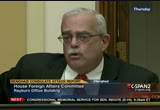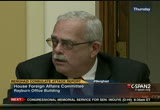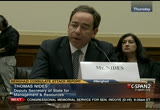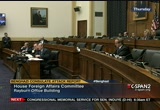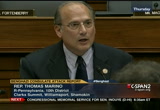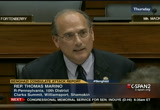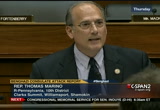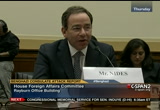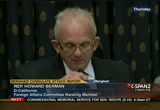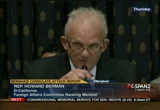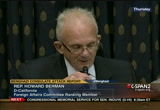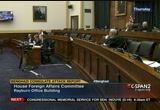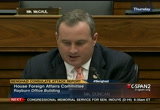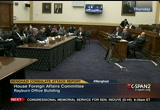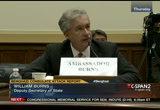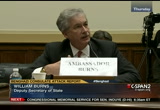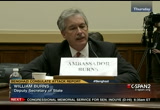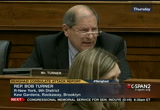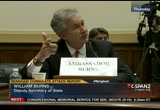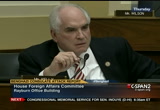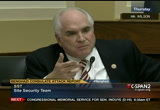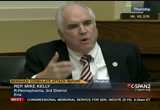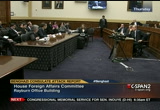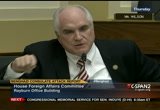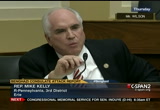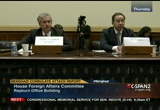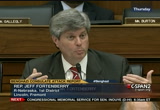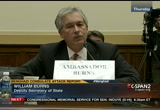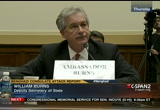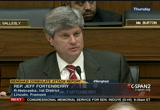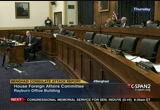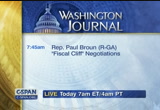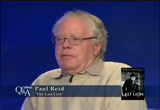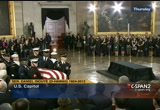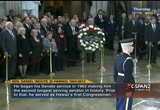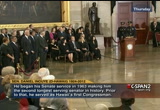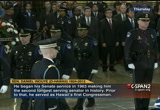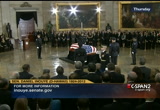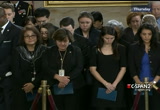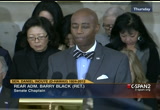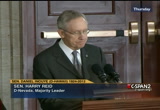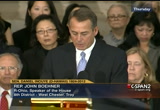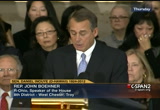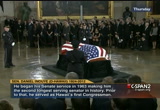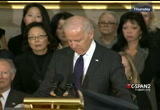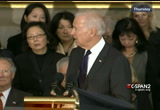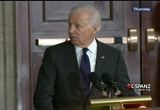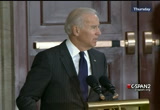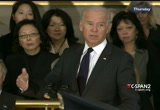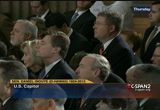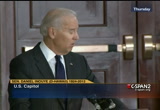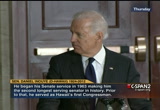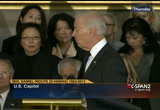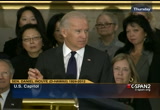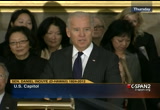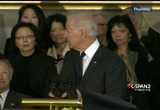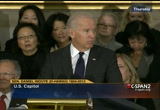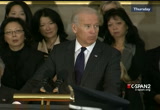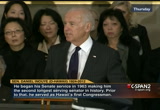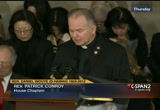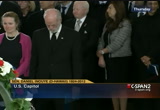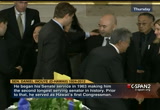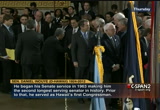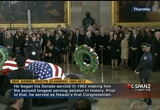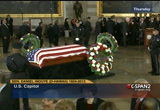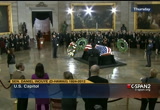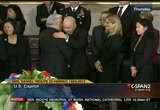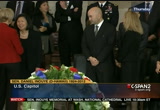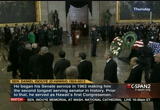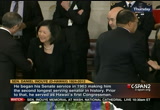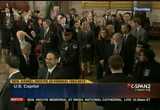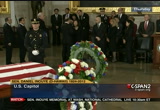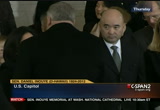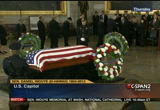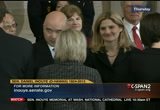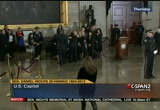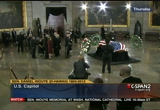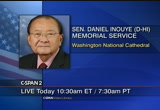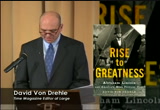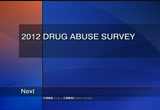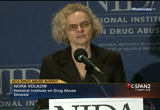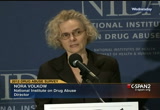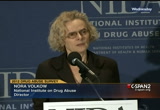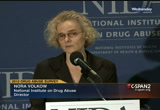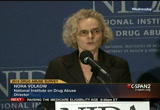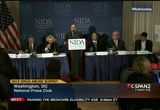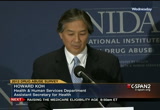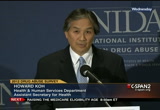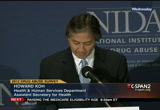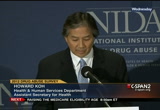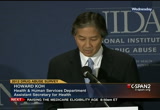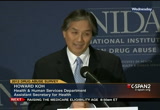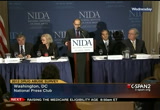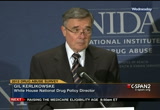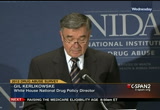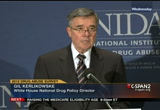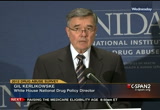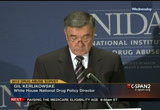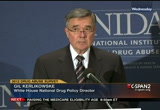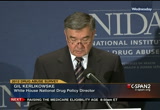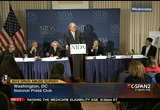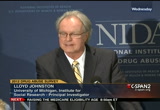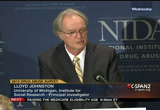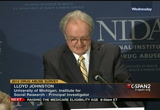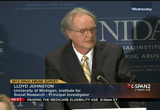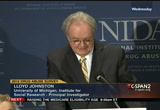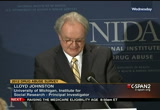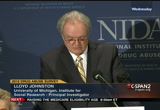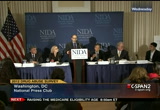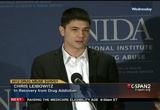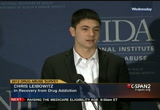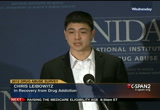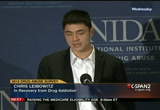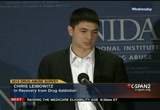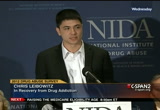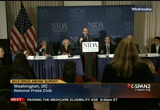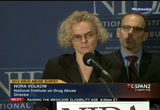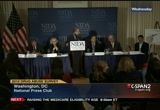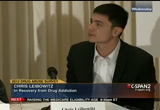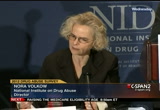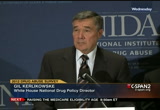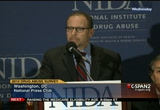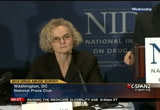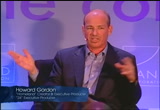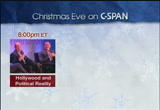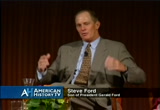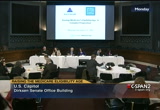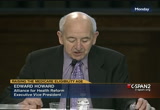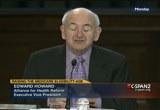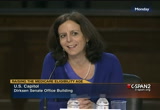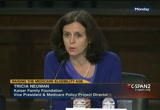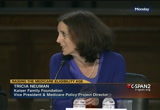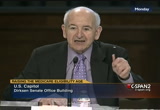tv Today in Washington CSPAN December 21, 2012 6:00am-9:00am EST
6:59 am
7:00 am
faced since. his mother, his mother, the first of her generation in hawaii, his father an émigre from japan. at a time when there was strong and prejudices still in existence in america, a man who came of age as the secondary burst upon the scene, and that very prejudiced against japanese-americans reached a crescendo. december 7, 1942, as the majority leader alluded to, on the way to mass, or on the way to church with her grandfather listening to your radio about the bombing that was taking place in pearl harbor. first as danny told the story, over several times, he thought it was the most -- he and his
7:01 am
father drove, he could see, could see pearl harbor, the bombs bursting. he was then labeled and any alien. he was labeled an enemy alien as his family was. because of his japanese ancest ancestry. but he thought for the chance to fight for his country. he had to fight for the chance to fight for his country. not just to prove that he was a loyal american but because, because he knew, he knew what was at stake because it was the
7:02 am
right thing to do. my mom was always taught my colleagues be for we came out, used as an expression. she would say chile, you're defined by your courage and you are redeemed by your loyalty. you're defined by your courage and redeemed by your loyalty. in the four years i've serve here, and were i still and the senate serving out that term, i would be senate pro tempore which is the seniormost senator roe, which is a frightening thought to think i'm that old. but i never met a man, or woman, in that period with as much physical and moral courage as daniel inouye. i never met a man with as much loyalty to his country, to his family and to his friends.
7:03 am
some who served with him a long time remember he's one of the few people who stand on the floor to defend a colleague who was under siege, without ever considering the political consequences for him back home. he always just did the right thing. he always had the moral courage to do the right thing your hundred and. he had a compass that always directed him, and he was resolved to do truly extraordinary things. things that few women and men ever contemplate, being able to consider doing. we all know that on april 21, 1945, and i had the privilege of being with them, we stopped and
7:04 am
went, we were with bob dole as well. ian bob dole -- literally as the crow flies, i think about two miles from one another, same time, same day, both mortally wounded fighting for their country. just above the bridges above tuscany. but because of detainees sense of honor, really think i can describe it to, when you hear the story, when you look at the record, his loyalty first and foremost to his you know, to the men he swore he would protect, he would do everything in his power to protect them. this is a man who kept fighting on the bridge even after his arm
7:05 am
was severed. prime get out of that hand, to get to the next machine gun nest, taking it out in the process. saving his men. a man who was awarded the medal of honor for his incredible bravery, but he didn't do it because he was brave. he did it he does he was loyal. he did it because of his sense of duty your he did it because this was his country. they could've been talking about danny when he said, when it defies fear, when duty throws the gauntlet down to fate, when
7:06 am
on earth scorns to compromise with the death, that is heroism. danny inouye in every sense of the word was a hero. if that's all he had done for his country, he would've contributed more than 99.9% of all americans contributed to the country. but his fight for his platoon, his fight for his fellow hawaiians come his fight for his country didn't stop. after 21 months in the hospital being rehabilitated, with two other men he came to know and love who had incredible character and courage as well, one has already been mentioned, bob dole who we all know, and feel heart, one of the finest
7:07 am
most decent men i ever had the privilege of murder at a great opportunity be collecting as a young kid. it was those giants, those giants and they are still giants, those giants in the senate. imagine the three of them spent 21 months together during the bulk of that time. through rehabilitation. danny went home and joined a movement for statehood. he returned to hawaii with a heart as full when he left, which is an amazing thing to me. when hawaii was admitted to the union and 59, its first representative as we all know was danny inouye. from the very outset, his colleagues knew that this was a special man. danny earned a muted almost what
7:08 am
everyone of us who ever served in either of these great houses long before. the uncompromising respect and admiration of every one of our colleagues. no one, no one in the four years i served with danny albert ever, ever, ever once doubted he would do what he said. never once doubted his word. never once wondered whether or not he would keep whatever commitment he made. that, that, that is the most valuable capital any man or woman who has ever served in this place could possess. and he had it from the outset.
7:09 am
no one, as i said, who is alive in state that danny inouye ever said something to me that he did not do. that's why he was so successful. no one ever doubted danny's motives. we all spend too much time in these chambers doubting the other man's motive. you can doubt their judgment but you shouldn't out their motive. no one ever doubted his motives. the law of the people of hawaii -- to love the people of hawaii had extended across the pacific, across the continent into these halls for danny. people not only listened, respected and liked danny. almost all of us who got to know him loved danny. how many of your colleagues can you say that about? you can turn and say it and mean it, i loved this man.
7:10 am
i loved this woman. for all danny had come through, from the sting of prejudice to his physical injuries to the deprivations he suffered, the losses he had, he would have been forgiven by all who knew him if he had an edge to him. if there's a tinge of bitterness, a touch of cynicism in his heart, he would have been forgiven for that. but the amazing thing to me was, there was none. there was none. i didn't know him, his whole life, but i never once saw him, even imply, why me? why me? danny had the most fulsome embrace of life with one arm that any man or woman could have
7:11 am
with two. if -- as we used to say, point of personal privilege, he came to campaign for me when i said to 90 okay running for the senate. he came to delaware and he spoke at the equivalent of one of our jefferson jackson dinners on the eve of our election. and i'll never forget my mom saying, chile, i like that man. i said why, bob? she said he likes you. i said how do you know that, mom? she said joe we, the highs, accomplish what she did to the, she said he has and and flexion for since. we all have five senses. very few people have sixth sense. that intuitive notion, the ability to look at another man or woman's eyes and understand them. to see them, to sense what they are thinking.
7:12 am
when i lost my family short after that i'm before sworn in he was one of the first of my future colleagues at my side. he encouraged me to keep up, awful hard look at the man was one arm through all he had been through, and he's telling me to keep up. and you say no now i can't do this. your dad did more for me than you'll ever know. when i decided to seek nomination for president, which i don't advise any of you to do, i didn't have to ask. if someone is really a true friend, especially those if you have to ask, it's too late. i didn't have to ask. i got a knock on my door, danny telling me, he would like to be
7:13 am
when national campaign chairman. that was the only time any of you start to question his judgment. [laughter] when i left the race, he stood by me when i was hospitalized for a long time at walter reed. he was with me. he supported me, and he did for me what i guess he may have done for a lot of you. you never know the good deeds another man's like danny had done. what danny did for me, danny gave me confidence. if danny inouye believed in me, i must be worthy of something. father, i know that sounds strange but i literally mean, i bet you all of had similar experience of mine. someone who looked at and you knew was a better man and woman then you, you knew it, and they
7:14 am
had confidence in you. i think the highest compliment a parent can give another man or woman is look at their daughters and say, or their son and say, i hope you grow up to be like that man or that woman. there's a lot of great men and women who have served here, we've had the pleasure of meeting. but all of us, all of them have some aspect of their personali personality, like i haven't everyone else does, which is not particularly admirable. but there wasn't one single attribute of danny's character that i didn't want my sons to possess. not one. there's never been another man but my father whom i've thought
7:15 am
about in terms of my sons dan danny. maybe that's why when he passed away, the first calls i got were my sons, bo andover, my son hunter was overseas, they had heard before i did. they knew your dad. they knew your husband. and what mattered most to them is they knew he knew them. as a matter of fact, it matters so much to microbes on, ma hunter, that when he did his senior paper at georgetown university, he went again and asked what what he could do about the 442nd, and would danny help him. i don't know how many times i heard my son tell the story to his friends about how he sat for several hours with danny,
7:16 am
hearing firsthand about the 442nd. you know, when you think of danny, what struck my family at least, not just his physical courage that is internal optimism, his embrace of life, untrammeled belief in the dignity of every human being. danny is known for all the great things he's done, the physical courage is shown, what is done -- but what drew me to danny was a speech he made in 1960 at the democratic convention about civil rights, about human rights. just as my son wrote about
7:17 am
danny, future generations will write about danny inouye. they will learn of his physical feats, maybe the most important lesson of all they will learn is the dedication to country, engagement in public life, engagement in politics, being a member of congress, can and should be the most honorable profession of all. danny made me proud to be a senator.
7:19 am
7:20 am
gentle, quiet strength, who, as a young man, nearly literally answered his master's call. for half a century, senator inouye did lay down his life day after day, serving those who looked to him to see to their security of their lives, liberties, and pursuit of happiness. all of this, thousands of miles from home. may we all be such good and faithful servants. bless us all, but bless especially his family who mourns the loss of so great a man, senator daniel k. in a way,
7:37 am
7:53 am
[background sounds] [inaudible conversations] >> another memorial service will be held for senator daniel inn inouye this morning at washington national cathedral. senate majority leader harry reid and eric shinseki will be among those eulogizing the hawaii senator who died on monday at the age of 88. you can watch the proceedings live at 10:30 eastern here on c-span2. >> i don't want to spoil the book for you, so let me just say that the year began with the american ree public in grave danger.
7:54 am
the union armies were struggling to grow virtually overnight from a few thousand men scattered across the continent to more than half a million. the inexperienced officers thrust into command of these raw volunteers were stymied by the sheer size of the breakaway confederate states of america. which covered a space larger than the entire european territory conquered by napoleon. lincoln's closest adviser was secretary of state william henry seward. seward said that even smart or people failed to see the difficulty of the union's task. they didn't apprehend the vast extent of the rebellion, as he put it. military operations, to be successful, must be on a scale hitherto practically unknown in the art of war. >> the second year of the civil
7:55 am
war, a strained federal government and weak union forces. david von drahle on 1862 and abraham lincoln's rise to greatness, monday, the 24th at 8:30 ian, part of four days of booktv this weekend and right through christmas day on c-span2. >> you're watching c-span2 with politics and public affairs. weekdays featuring live coverage of the u.s. senate. on weeknights watch key public policy events and every weekend the latest nonfiction authors and books on booktv. you can see past programs and get our schedules at our web site, and you can join in the conversation on social media sites. >> a survey by the national institute on drug abuse shows that drinking and cigarette smoking was down among high school students in 2012 but marijuana use remains high. the director also noted that abuse of at roll was -- attar
7:56 am
old was with also a concern. >> every year we do a survey of the future. >> indicators that are not changing and indicators that are showing there was a positive side. i'm going to side with those on the negative side because i think we need to pay attention to them in order to be able to prevent from continue to go up, and that relates to the
7:57 am
marijuana use. over the past five years, we've seen significant increases in the use of marijuana among teenagers, high school students, eighth, tenth and twelfth graders, and, indeed, we have significantly high levels of daily use of marijuana. according to the survey, 6.5% of twelfth graders are using marijuana daily and get only 44% of 12th graders perceive daily marijuana use as risky. and this very low perception of risk for regular use of marijuana is at its lowest since it's been in 1983. coupled to these increases in marijuana, we have seen throughout surveys done a significant increase in the number of admissions for marijuana abuse which have significantly increased as well as increases in the admission for emergency medicine room
7:58 am
departments. so, clearly, the use -- the increases in use of marijuana are being felt in terms of their consequences. another indicator that is worrisome is that a relatively recent role which is that of synthetic -- [inaudible] are actually, which came into the market, as i said, relatively recently, are already abused by 11% of 12th graders in the past year which is an extremely high number if you think about it. considering then that you have on the one side marijuana increases and on the other one the synthetic -- [inaudible] we're actually recognizing that we're going into an era where the synthetics are being favored. i always get asked the question, well, why worry about marijuana, isn't alcohol and nicotine more worrisome, and my perspective is it's not necessarily to place
7:59 am
one drug against the other. all of these drugs, actually, can have profound and adverse or consequences, and my question has always been the more you make a drug available, the higher the number of people that are going to be exposed to it. and we know from surveys that perception of risk is actually one of the factors that predicts whether a drunk person will take marijuana. we also unequivocally know that the use of marijuana during adolescence is deleterious for the function of the human brain that actually translates into impaired cognitive performance and worse outcomes. with respect to the indicators that are actually going in the right direction, many of the illicit substances are actually decreasing and this is, actually, very, very good news. of the illicit drugs, alcohol, nicotine continue to go down among teenagers, and for the case of nicotine, across all of the grades this is the lowest prevalence rates have been since
8:00 am
the inception of of these measurements. similarly for alcohol, we're seeing decreases in the patterns of alcohol use across all ages, and because both as of now, we know that alcohol and nicotine are the drugs that cause the greatest rates of morbidity and mortality, this is actually quite wonderful news that also identifies the success of prevention efforts. we've been able to decrease the -- [inaudible] of alcohol and tobacco use in young people because of a very aggressive prevention campaign. now, with respect to indicators that have not changed much that are still worrisome is the pattern that we're seeing of abuse of prescription medications through our country. most attention has focused on the use of pain medications that contain opioid because of their association with the rate of overdose and death. the patterns as it relates to vicodin have gone down since its highest numbers of 10%. they are currently at 7.5% on
8:01 am
the past year. but on the other hand, those of oxycontin have remained table at 4.5% for 12th graders in the past year. and as much as these drugs are highly addictive and high risk of overdose, this continues to be a major priority with respect to prevention. unfortunately, we are seeing an increase in the abuse of stimulant medications which are used for the treatment of attention testify sit disorder, in particular amphetamine deerall which can be higher addictive, but it's also being used as a means to improve cognitive performance. currently, 7.6% of 12th graders admit to the use of deerall in the past year -- attar or all -- adderall. i think they are identified areas where we need to pay attention and not become come play sent irregardless of our
8:02 am
perception of whether this drug is worse than the other. we do recognize the more available a drug is, regardless of its addiction potential, the worse the outcomes. so we need to put ourselves that question, do we want to be facing abuse that we are seeing with legal drugs for some drugs like marijuana, or do we want to do prevention efforts that can avoid all of the human cost and medical consequences? thanks very much. [applause] >> thank you, dr. volkow. i failed to mention that dr. volkow has been the director since 2003 and has literally led the efforts to insure that drug addiction is viewed as a chronic brain condition, and we really do appreciate the leadership that dr. volkow has taken in leading us in that respect. our next speaker is dr. howard koh who serves as the 3th
8:03 am
assistant -- 14th assistant secretary for the u.s. department of health and human services. after being nominated and confirmed by the senate in 2009, he oversees a number of offices including the office of the surgeon general and the department of health and human services and also serves as senior public health adviser to the secretary of health and human services. with that, dr. , koh. [applause] >> thank you very much, dr. stein, for inviting me to this very important conference, and i want to express my gratitude to you and to dr. volkow for her leadership, director control kousky and his new deputy directer, mr. leibowitz, thank you all for being leaders, and a special thanks to dr. johnston because monitoring the future is a treasure for public health, so it's a great pleasure for me to be here. in examining the results that are being unveiled today, we
8:04 am
should remember that of all these agents, that tobacco remains the leading cause of premature and preventable death in the united states. smoking kills more than 1200 americans every day, and for every tobacco-related death there are two new replacement cigarette smokers under the age of 26. it's tragic that these replacement smokers are kids who start when they are not fully ready to make an informed choice. and, indeed, you have heard -- and it is true -- that tobacco addiction is a pediatric disease. three out of fourteens who smoke continue to smoke into adulthood, even though they intend to quit, and a typical smoker loses 13-14 years of precious life. so today we announce that cigarette use among youth is dropping and that's, of course,
8:05 am
very positive news, but that still means that nearly one in five high school seniors -- specifically 17.1% -- are still using cigarettes in the past month. and then we should remember that kids are not just replacement cigarette users, they also use an array of other deadly tobacco products as well. the industry continues to create many tobacco products that youth find appealing. for example, some cigarette-sized cigars include fruit and candy flavoring like strawberry and grape. and furthermore, kids now have access to the latest smokeless tobacco products which are pitless or dissolve like mints. so these are appealing to young people in part because they can be used as school or at home in front of mom and dad and not be detected. unfortunately, these products
8:06 am
too cause nicotine addiction and can lead to serious disease and even death. the data being announced today suggests a considerable amount of use of other tobacco products with more than a quarter of 12th graild males -- 27.1% -- using small cigars. and furthermore, use of other tobacco products such as hooka is also at a high, 18.3% of high school seniors report using hooka with tobacco in the past year. so in summary, while the declines in youth cigarette use is encouraging, we must do more overall to help kids be tobacco-free. and furthermore, the significant use of other tobacco products threaten to offset the gains made in the declines in cigarette use to date. so what should we do?
8:07 am
we know what works: supporting comprehensive tobacco-free and oh evidence-based tobacco policies, fully restoring the 2009 with family prevention and tobacco control act, expanding use of tobacco cessation services and using media to educate and encourage people, especially young kids, to live tobacco-free. last month the department of health and human services unveiled be tobacco-free.gov, it's a unified web site for our department. please visit it. also we're very pleased to note that recently our food and drug administration, the fda, announced an award of nine contracts with a budget of up to $600 million over five years to develop a sustainable public health education campaign to address the per or vasive -- pervasive public health problem of tobacco use in kids. so we are looking forward to coming back to you in the future to tell you how this campaign
8:08 am
will be unveiled, how it will be launched and how we focus on many parts of the youth population to send a message of prevention. now, overall in this survey is so valuable because it reports usage rates not just for tobacco, but all illicit drugs and alcohol as well. and when you put it all together, some 40% of tenth graders and about half of twelfth graders are using at least one be not several -- if not several of these substances. so, again, we must work together to promote pree vex, work with kids and parents, enforce alcohol control policies, create environments that empower young people not to drink, use other drugs or use tobacco, identify alcohol and other drug abuse disorders early and provide
8:09 am
brief intervention, referral and treatment and reduce inappropriate access to a use of prescription drugs. i'm very grateful to dr. volkow and to nida who have helped. we urge you to view drugabuse.org to view tear principles of prevention, and you may also want to look into the family check-up, a tool developed by the child and family certain at the university of oregon which highlights evidence-based parenting skills in preventing initiation of drug use among youth. so as i close, we should remind ourselves that our good health is a gift. it is precious, it is fragile, and it's particularly fragile for our kids. so while we've made progress on a number of these issues, we need to redouble our efforts for
8:10 am
prevention. we all can do more to help our kids enjoy a fighting chance for health. thank you very much. [applause] >> thank you, dr. koh. i've had the fortunate opportunity and unique one to interact with dr. koh and his staff over the last number of years on a number of initiatives, and currently, of course, working with dr. volkow and previously having the opportunity to work with our next speaker who is mr. gil coal kousky who was nominated by president obama and confirmed by the u.s. senate as director of the office of national drug control policy in the white house. in this position, he coordinates all aspects of federal drug control programs and implementation of the president's national drug control strategy. he brings 37 years of law enforcement and drug policy
8:11 am
experience to the position and most recently served for yard ne years at chief of police in seattle, washington, where he left crime at it lowest in 40 years. [applause] >> well, good morning, and thank you very much for being here, and this is the wonderful opportunity for me to associate, again, on this monitoring the future report with dr. volkow. and i thank her and actually the great staff that supports dr. johnson and the work that he has done. and the assistant secretary of health, dr. koh, could not be a stronger partner on these health issue, and his words about the health of young people and the responsibility we have as adults for them, i think, are particularly important. and, chris, i'm looking forward to hearing from you. and it's always a great pleasure to be with dr. johnson who has given us the information that
8:12 am
helps so much in not only making policy, but also the information that's needed to improve the nation's health and particularly the health of young people. so there are a couple important things i think that i really took from this report, but to put it a little bit into context, remember that this is that snapshot of the prior year, and it's also, i think, helpful to think about where we've been in the drug abuse and the drug field for the last number of decades, actually over the last three decades. so as we craft policy, it's very helpful to take a look at that. and we've actually made huge strides forward in reducing illegal drug use in america. despite some of the increases in drug use over the past several years, over the long term the rates of drug use among young people today are far lower than they were 30 years ago. but we have to continue a
8:13 am
downward trend, and we have to work on that very hard. and we have some troubling signs, as dr. volkow mentioned. we have to continue to educate people, particularly young people, about the risks that are associated with drug use. and just as we've actually educated people about the harms of tobacco and the dangers of alcohol-impaired driving, that information needs to be communicated not in a threatening way and not in a scare tactic way, but it needs to be communicated in a very direct way by parents and others, other adult influencers as we like to call them that can provide that kind of leadership. as the president has noted, we've successfully changed attitudes regarding smoking and alcohol-impaired driving, and we very much can do the same when it comes to the findings around drugs. we recognize the impact that drug use has on this country, and too many of us have been touched by lives that have been cut short by anover dose, futures that have been
8:14 am
significantly reduced or impacted by substance abuse dependence. unfortunately, drugs hold back too many americans from living up to the best things that they want to achieve in their lives. and today's findings give us some insights, information that's going to be used to develop these evidence-based policies. not the policies of ideology and not the policies of which way the winds happen to be blowing on this issue, but the evidence and the research and the data that's needed to make a change. and the young people represented in today's studies are making decisions that really are going to define their future x they're going the define the future of this country. and the health of the next generation of americans, of america's leaders and innovators and citizens is just critically important to all of us. they deserve the strength and the support from us to make those healthy decisions and to choose a life that isn't hindered by drug use. and that's why the monitoring
8:15 am
the future survey is so important, and it connects us to their experiences. and thanks to the work that's gone on in this survey, we really do have the information that we need. well, the obama administration is focused on one particular area, most recently, that dr. volkow mentioned, and that's certainly prescription drug abuse. this year's monitoring the future results show that work has yielded some positive outcomes including a decrease in the past month use of pain relievers by high school seniors. and to continue to help prevent the abuse of prescription drugs, we really encourage americans to keep track of the prescription medications that are in their homes and to dispose of those unused or unneeded medications properly. and we have a lot of information on our web sites that are very helpful to you in that. i think that the message that dr. koh presented on the anti-tobacco and the underage drinking issues are particularly
8:16 am
important to the health of young people, but in spite of the overall decline in the use of many illicit drugs, today's survey also contains some disconcerting news. marijuana use among teens remains at unacceptable levels, and it has increased in all three of the grade levels mentioned in the recent years. there's another troubling point. over the past several years, the perception of harm and the perception of risk around the use of marijuana has declined, and the percentage of high school seniors who believe smoking marijuana regularly is harmful is lower than it has ever been since the 1970s. and historically, this dip in the perception not only leads to increased use, but we've certainly seen that in the survey's results. in fact, more students now report smoking marijuana during the past month than they do smoking cigarettes. often users are uninformed and, frankly, they're naive about the dangers posed by these
8:17 am
substances, the substances such as k2, the synthetic ca nab noweds that have have been receiving a lot of media attention and first were brought to real awareness by the survey's instrument results from two years ago. that was particularly helpful. we hope that we'll start to see some decreases in the use of these synthetics, but the troubling numbers in this survey particularly show that young people can tend to turn to those also. the most of the one-time use of 12th graders reporting synthetic cannabinoids is really alarmingly high, and despite, of course, the psychotic effects and the stories that you've read in the press about the results of some of this, some of the use of this, of k2 is really very troubling. we're in a media environment that makes it difficult for parents and adult influencers to communicate the dangers of
8:18 am
substance abuse, and we have to redouble our efforts to prevent more needless harm associated with it. in recent years we've seen an increase in the abuse of the stimulant adderall among high school seniors accompanied by a decrease in the perception of risk associated with that drug and the with availability of adderall on college campuses having gone up, we have to carefully examine how young people are obtaining those drugs. and that brings me to my final point, and while we're re-examining how young people obtain adderall, showing them how marijuana use harms the developing brain or empowering them to live free of tobacco and alcohol, the parents and the teachers and the coaches and the mentors and others can really have such an incredibly positive effect on young people's lives. and prevention is the very best tool that we have. our national media campaign is called above the influence. we've been amazed to see about
8:19 am
two million young people that have taken up that message of prevention, and they make it their own through their own interpretation of art and poetry and music and the written word. and i think that those are powerful statements, and we hope you take a look at that. we've been humbled to see the energy and the creativity of america's youth as they assert their own aspects of being healthy, making positive choices in their lives and refuting the pro-drug messages that can so overwhelm them. we continue to support that spirit of prevention through that web site about the influence and through that media campaign. with that, i will turn this back over to dr. stein and thank you all very much. [applause] >> and thank you, director. our next speaker is dr. lloyd
8:20 am
johnston who is the distinguished senior research science at the university of michigan's institute for social research and the principal investigator of the monitoring the future study since its inception in 1975 which is a, an amazing contribution that he has provided over these last several decades to understanding the trends in drug use amongst youth in our country. we served as an adviser to the white house, congress, many other national and international bodies and has conducted research on a wide variety of issues including, of course, the use of alcohol, tobacco and various illicit drugs. so i'm going to turn the podium over to dr. johnston. [applause] >> thank you very much, and good morning to all of you. pleased that so many of you have turned out. it's a pleasure to, again, be able to announce results from the study, joining the director,
8:21 am
assistant secretary koh, director volkow. we all did this last year and hopefully next. despite all those years, i actually get younger -- [laughter] each time we do a survey. special arrangements upstairs. um, you heard a lot of the results of the release, so i'm going to sort of focus on some of the highlights that i think are most interesting and most important this year. one of those has to do with bath salts. you've heard a lot in the press about bath salts and how dangerous they can be, and i think i believe that. but i don't believe there's been any very good empirical evidence of how extensive their use is. and for the first time this year we had it in the survey, and we find, fortunately, that the results are very low levels of use. a little over 1% have used in
8:22 am
the past year among 12th graders, less than 1% of the eighth and tenth graders. um, now, that's the good news. it could be that we're getting in on a late downturn because according to the national poison control centers, um, their reports of bath salts went up dramatically in 2010 but have been declining since and dropped by more than half, and they're still declining. so i think maybe what's happened here is, first of all, the fda scheduled some of the ingredients used in these over-the-count canner drugs which, by the way, have nothing to do with bath salts, that's just the term that's used the make them look legitimate. and in addition i think the media coverage has been so intense about the adverse effects of bath salts that probably a lot of kids have gotten the message. so anyway, the main point is that we're at low level compare today what we might have had. now, as you've heard synthetic
8:23 am
marijuana, that's not true. this is a synthetic drug that has really made inroads, and it's the second most widely-used drug among eighth and tenth graders, the third among twelfth graders after marijuana in every case and after inhalants among the eighth graders. and today we have 11.3% of the seniors or one in every nine indicating that they've used synthetic marijuana which they buy in various head shops or novelty stores of various kinds, um, in just the past year. and that's disturbing. and what with's more disturbing -- what's more disturbing is it hasn't gone down. it's exactly where it was last year despite the fact the dea scheduled a number of the drugs which are used in these substances. now, marijuana, of course, remains the most widely used of all the drugs. that hasn't changed for many years. but after rising for four years, it actually leveled off this
8:24 am
year at, perhaps, an unacceptable level, but it's, it has at least leveled off. the bad news, as you've heard, is that daily marijuana use has maintained at a high level, probably the highest in the last 30 years that we've seen with 6.5% of high school seniors saying they spoke pot daily, in just the past month. and that's about one in every 15 seniors. so if you're looking at a class of 30 kids, two of them are heavy pot smokers on average. and given the increasing information about the consequences of that including dependence, including brain damage, including the effect on iq, um, that is really of concern, i think. there are positive developments this year, for sure. ecstasy is down, salvia is down significantly, inhalants are down, and taking heroin without
8:25 am
using a needle is also down. that was the former heroin use that really burgeoned in the '90s and had a lot, a lot of users to heroin. above and what people were using with needles. and ore narcotic -- other narcotic drugs, as you've heard, specifically oxycontin and vicodin were down significantly this year if we looked at the three grades combined. and the proportion of kids using prescription drugs of any kind has leveled for several years. it's about 15% of the high school seniors who say that they've used one of the rx drugs without medical supervision in the prior year. those who think like amphetamines or tranquilizers or narcotic analgesics. and most of the remaining drugs -- and there are many now -- either held steady or showed nonsignificant declines this year. many of them are well below
8:26 am
levels that they've been at, say, five or ten years ago. um, this, the level includes some important ones like cocaine and crack, methamphetamine, crystal methamphetamine, lsd, steroids. now, you've heard about a couple of the illicit drugs. cigarette smoking continues its long-term decline. it's really quite a dramatic decline over the last saw 15 years. -- the last 15 years. and it was down again this year from if you average across three grades from 11.7% who used in the past 30 days to 10.6. that's statistically significant, it's about a 9% drop in the number of kids who are smoking. and i can't really begin to tell you what that's going the mean for the long-term health and longevity of these youngsters. as dr. koh has alluded. something else that i found this
8:27 am
year was that speaking of dr. koh is that those other forms of tobacco he's particularly concerned about, smokeless fact in general -- tobacco in general, has declined. but the other forms like hooka and dissolvable tobacco, so forth, all of those have stayed level this year. so i think in a way that's good news. you'd like to see them down. small cigars too. and alcohol, um, is really at the lowest levels we've seen in the life of this study, as are cigarettes, and that's pretty dramatic change, i think, for as enculture rated a behavior as alcohol consumption is in this culture. but this year it only continued down among the eighth graders, leveled among the tenth, and the twelve graders actually showed a slight uptick. it went from r 22% to 24% who
8:28 am
said in the past two weeks they've had more than five drinks in a row at least once. alcohol availability to eighth graders did continue to decline. as did tobacco availability. so i think some policy efforts out there probably at the local and state levels are having an effect in cutting down access to these drugs for young people. so to summarize, marijuana use has leveled, though daily use is still unacceptably high levels. synthetic marijuana use also has leveled, but it remains at a high rate, one in every nine 12th graders. cigarette smoking is declining and is at historically low levels. alcohol use is declining, but it's up a little in 12th grade. and a number of these specific illicit drugs including some very important ones are declining. but finally, as i started, bath
8:29 am
salts have not made a very serious inroad at this point. i think that's encouraging. thank you. [applause] >> thank you, dr. johnston. before we open it up for questions from the press, we thought it would be important to ground us in terms of people who are most affected by the findings of this survey, and that really is our future generations. and we came upon our next speaker, l. chris leibowitz, a couple of months ago at a town forum in arlington, virginia, and were so struck by his story that we invited chris to come and join us today to speak briefly about his experiences and help us get a better perspective of how the impact that these findings may have in our future prevention efforts. chris? [applause] >> hi.
8:30 am
thanks for having me up here. i don't necessarily feel qualified to stand up here with you guys -- [laughter] but, you know, what are you going to do? i'm here. [laughter] so i've never done bath salts. i was just thinking about that. but i know for me when i was using drugs, um, i probably would have used bath salts if it was available because my drug of choice was, yes, like, i'll take it. whatever was laid out in front of me. but it started with using marijuana because a couple of you guys that were talking about alcohol and marijuana, or alcohol and cigarettes, they weren't really available when i was 13. and, you know, they were controlled. and you needed an id. and when you're 13, it's hard to have a fake id that says you're 21. so marijuana was available, and
8:31 am
it was natural, man, you can smoke it, it's all good. and that's what i did. and i was terrified of it, you know? everyone told me it was a gateway drug, and then my friends were like, dude, that's propaganda, man, it's all right. so i ended up smoking weed when i was -- marijuana when i was 13, and, you know, it hit me, and it had this effect of, that i wanted, and i chased that, and i built my life around that pretty much. my group of friends sort of dropped off, and i started hanging out with people who smoked marijuana like i did. that was it. and, you know, eventually it wasn't enough. eventually just smoking marijuana was not enough. and i remember the first time i did something else. i was at a party, and i was high from smoking, and someone put
8:32 am
out this white line in front of me, and i was like, what's that? and they're like it's cocaine, man, it's just coke. and i was terrified. i think i was like 16. and i was terrified of it because of all of the stuff that i heard. but the only thing that came out of my mouth was yes. and i did it. and i remember looking back, like, a couple minutes after i did it like, oh, my god, i just did cocaine, oh, my god. what am i going to do? and, you know, what i proceeded to do was use more cocaine for the next couple months, and, you know, just like what a couple people were talking about up here, i ended up getting vicodin from one of our friends' parents' medicine cabinets, and i took that, and it was like, you know, my tolerance was getting higher and higher with these other drugs, and when i took that, it's like i had the this feeling of, yes, that's what i want. and eventually -- i grew up in
8:33 am
mcclain, virginia, and oxycontin just sort of flooded, flooded our town. and we used it -- or i used it a lot. and eventually, you know, i started -- somehow i started dealing drugs, i started, i was this ox i con tin drug dealer before -- oxycontin drug dealer before i even knew it, and, you know, started going through withdrawals of the drug. you know, the people started cracking down on oxycontin use, and it was harder to find. someone was like, hey, man, heroin is -- all of a sudden we were scientists or something. they're like it's only a couple molecules away from oxycontin, man, it's really not that different. [laughter] and i was like, okay, a couple molecules is nothing, yeah, i'll do that. and, you know, that night i shot, shot up heroin, and i remember, i remember the same moment, i kept having these moments of did i just shoot up heroin? like, what is going on? i need to stop.
8:34 am
but i didn't want. but i didn't. and eventually my tolerance got high with that, and it's like with any drug, um, i had to steal, you know, i'm a convicted felon today because i was stealing every day to get my drugs. i needed the drugs. my whole life was these drugs, and i needed these drugs. and when you steal every day, you go to jail is what happens. and i went to jail. and, um, you know, finally, you know, it's like reality hit me. it's hike what are you doing? it took a couple times of going to jail, you know? it took the last time of them putting me in jail and the magistrate saying, no, you're not gotting a bond today. -- you're not getting a bond today. you keep doing the same thing every time we let you out, so you're staying in here. that's when reality hit me in the face, and, you know, i eventually got out of there a couple months later on the conditions that i go to treatment, and i ended up going to this treatment center called
8:35 am
a new beginning in chantilly, virginia. and, you know, i stayed there for three months, and that was in january 2010, and i've been clean since. but, you know, what the people that i talk to at national institute of drug abuse wanted me to talk about, you know, i don't think i ever would have snorted that line of cocaine if i wasn't high that night. not saying i'm a victim of marijuana. i don't think i'm a victim of anything. i chose what i chose, and, you know, i'm here today because of that, but, you know, i would have never gone from growing up in mcclain and playing sports and doing all the things that i was to injecting heroin, you know what i mean? that never would have happened. any of the people that i meet today, um, that have the same story that i have, it never happened like that. it was a very slow lowering of
8:36 am
the bar really, not raising it, you know? and for me my start was smoking marijuana. it sort of opened up, opened up this world that led me to being a convicted felon and, you know, whatever. so, but i'm really grateful to be here. i don't really know what i'm doing here. i was telling, telling my friends, like, all of these speakers have, you know, directors and, like, ph.d.s and doctors, and it's like i work at starbucks, man. [laughter] i really don't know -- [applause] what the hell i'm doing here. but -- [applause] yeah. one day, i am going the school for social work with, and i do, i hope to, you know, have my own practice or, you know, work in a treatment center, working with adolescents who are in addiction. so i'm really grateful to be here and meet you guys, so
8:37 am
thanks. [applause] >> chris, you are more than qualified to be here, trust us. [laughter] thank you for sharing your thoughts. we have some time now, of course, and we'd like to open the microphone up to questions from the media. we'll be fielding questions from the media here in the room first, and then we have some who are on the phone and maybe chiming in then as well. after the event is over, for those of you who are not with the media, our panelists, some of them will be available to interact with you on a one-on-one basis, so we're happy to extend the invite to you in that respect. if there -- i don't think there's a floating microphone -- there is. so, please, state your name and the affiliation that you are with. >> okay. donna with "usa today." this is for anyone who wants to take it. what impact do you think the state, the various state debates
8:38 am
on legalizing medical marijuana or decriminalizing marijuana has had on youth perceptions and this, um, sort of high use of daily marijuana among teenagers? >> dr. volkow? >> what we've been seeing, for example, just to answer the question with respect to prescription drug use, we were interested on knowing why kids were starting to favor these drugs, and one of the consistent findings is their belief that because they are being prescribed for medical purposes, there are actually less risky. so you explan late that -- extrapolate that the dialogue of -- [inaudible] the messages that we're saying is equivalent to that of the prescription medications because they are prescribed for medical purposes, they could not be so harmful. so that, i think, is one of of the elements that's contributing. at the same time, we also recognize that individuals, one of the factors that contribute
8:39 am
for people not using drugs is their illegal quality. and that is a deterrent for many individuals. and when you start to have a debate and you have some of the states where this is actually no longer the case, then that deterrent is not present. so we can actually avibe those two factor -- ascribe those two factors to increasing the likelihood of people getting exposed to the use of marijuana. >> thank you. are there questions from the floor from the press? >> [inaudible] >> okay. [laughter] "usa today"? >> this is for chris. how old are you now, and what were some of the things that, um, affected your perceptions of the risk of marijuana? >> be i'm 25, and, um, i guess
8:40 am
some of the biggest perceptions that i had, the influences i had on my perception of marijuana was the people around me. like my older sister, i knew, had used marijuana and had a boyfriend, and i remember i looked up to him, and, you know, sort of people in my neighborhood, the cool kids in school. that's, that's sort of the perceptions that i had. also i remember hearing some stuff during, like, health class about it, but the only thing that i remember about marijuana, us being taught, was that it wasn't addictive. that's the only thing i remember about that. >> thanks, chris. >> which is untrue. >> if there are none from the floor, i will -- is there one over there? yes, sir. again, please identify yourself and thank you. >> i'm patrick healey from
8:41 am
gonzaga, a member of the community for concern. do you see a higher risk of substance abuse in a youth's household where an older sibling has used drugs compared to when an older sibling hasn't? >> do you want to -- >> actually, that that's a very good question, and even though i have not seen specifically surveys to try to actually address that, i would basically predict that you will. because, for example, what we, what surveys have shown is that the perception that kids have of other kids using drugs is a very good predicter of whether they would take the drug or not. so if they're perceiving that others are actually taking the drug, they're much more likely to do it. and i think that chris' response also attests to that. so kids are very much, actually all us humans intimidate our entourage, and we learn from others, and relationship with siblings is probably one of the closest ones. >> thank you. thanks for that question.
8:42 am
um, are there, is there a question there? yes, please. >> hi. i'm monique from school without walls, and, um, do you believe that incarceration and mandatory might minimum sentencing for substance abuse is more effective than rehab and community-based programs? >> i can answer that. i think if you look at president obama's drug strategy, the very first one that was issued in his administration in 2010, it's very clear that not talking about this is a war on drug, that minimum mandatory sentences, the president was the first president in four decades to actually reduce a minimum mandatory sentence. and that was on crack and powder cocaine. and he did that in a bipartisan way with congress. so the focus of the president's drug strategy is all around
8:43 am
public health, public education, prevention programs, etc., and we're seeing that, that same federal policy being used by a number of states. so i don't think we could be any clearer that incarceration levels and minimum mandatory sentences for drug addiction and use of drugs -- not drug trafficking -- and use of drugs is not a particularly effective way, and we've seen a very great movement away from that both at the federal level and at the state level. >> [inaudible] >> a reporter from the phone, can we open that line? >> i have a question for -- [inaudible] please go ahead with your question.
8:44 am
>> your line is open. please, go ahead with your question. >> yes, this is dirk hanson, and i was wondering if dr. volkow could comment on the question of whether or not we believe at this point that bath salts and spice-type marijuana are, in fact, addictive drugs. >> yes, and the answer is, actually, we know that they are addictive drugs. the bath salts are stimulant-like drugs with some perceptual distortion properties. but from work that has been done for many years on this type of compound, we know that they actually can be addictive. with respect to the cannabinoids, now it is the data
8:45 am
unequivocally shows whether we want to accept it or not that the drugs that target the cannabinoids receptor actually can produce addiction in those individuals that are vulnerable. >> thank you. is there a happened up there? a hand up there? >> hi. i ameymy flurry, and i'm the president and co-founder of the community of concern which is an initiative to educate parents about, um, the effects of alcohol, tobacco and other drugs on young people. my question e relates to the use of marijuana. are there any studies that show brain imaging relating to the effects of marijuana on the development of young brains? >> yes. and, actually, it's very interesting because this year there were two really important studies that showed, and that's
8:46 am
why i felt comfortable to say clearly giving evidence that the effects of marijuana during adolescence are deleterious for the human brain. and both of those stories, one of them was on imaging, and the other was measuring iq. this basically demonstrates that exposure to marijuana during adolescence when the exposure was in adulthood got significant changes both in the connectivity of the brain and on having lower iq on the other. the brain imaging study actually was very interesting because it specifically showed that the fibers that connect the hippocampus which is the area of the brain more involved with memory and crucial for learning actually were dramatically reduced. and when i speak dramatic, it was a 90% reduction in the intensity of the -- in the density of the fibers connecting with the hippocampus, only those
8:47 am
exposed difficultly to marijuana during adolescence. and the other which showed a lower iq was actually a very important study because it actually was one of the first ones on a large sample size to document a decreasing iq even after they corrected those individuals before they got exposed to marijuana. how to you know that these lower cognitive performance on these kids taking marijuana is not because they started with a lower iq? so those two studies allow us to answer at this point that exposure to marijuana during adolescence is actually harmful for the brain. >> thank you. we are almost out of time, and so we could probably field one more question from the press, and if not, we can begin to conclude. with that, i would like to thank everyone for their attendance here. a quick reminder that the nida
8:48 am
national drugs fact week begins january 28th. you can find out more about that on our web site at drugabuse.gov, and with that, i'd like to thank all of our panelists and for you attendants today and to be tracking this activity on the nida web site. so thank you all. [applause] >> i think that in the 24 it was of the idea, and it was promoted in certain articles, and i think there was a conflation of politics because joel, who created the show s a public conservative. i mean, the spectrum of political affiliations on the staff were, you know, from the far left to the far right. but there was no agenda. the idea that there was an agenda which was really the charge that was being forwarded, that we were somehow the midwife to a public policy on
8:49 am
interrogation was absurd, it is absurd. whichn't so today -- which isn't to say that if, in fact, our content was affecting the behavior of interrogators in the field, even the if it was, you know, .05% of those interrogators actually were taking their cues from jack bauer, there was a systemic problem for sure that i suggested that we try to intervene on the behalf of those people, and to try to, you know, disabuse them of the fact that this is a television show. and so, you know, and it is a television show. but it did -- and, again with, i may be pollyannaish about this, but the fact that 24 became the political football that it became for a while, i think, was a very valuable thing. >> monday night at 8 on c-span, how movies and television portray politics and policy making followed at 9:20 with george will on the historical link between religion and politics, and at 10:50,
8:50 am
8:51 am
sitting around the dinner table and mom is cooking dinner and she looks over at my dad and she says, jerry, something's wrong here. [laughter] you just became president of the united states and i'm still cooking. [laughter] >> steve ford, linda johnson rod and jenna and barbara bush on growing up in the white house sunday evening at 7:30 p.m. pacific. >> a group of health care policy analysts discuss proposals to raise the eligibility age for medicare and the effect it would have on seniors. currently, 65 year olds get medicare benefits. the alliance for health reform hosted panelists from aarp, the kaiser family foundation, and the american benefits council. this is an hour and a half. >> [inaudible conversations]
8:52 am
>> if i can have your attention we're going to try to get started. my name is ed howard. i'm with the alliance for health reform, and i want to welcome you on behalf of our board of directors and our honorary leadership, senators rockefeller and blunt, to a program about proposals to gradually increase the age for medicare eligibility from 65 years to 67. now, it's a topic that's been under discussion for a long time, back when i was on the staff of the didn't exist and house aging committee. this was a topic that came up from time to time. it's particularly coming up now, of course, in light of the ongoing rise in the age for full social security benefits, from 65 to 67, and, of course, it's front and center in the current discussions about how to curb
8:53 am
the federal deficits and avoid having as thing ourselves over the so-called fiscal cliff in a couple of weeks. we are trying to sort out the pluses and minuses of this proposal, which we find is more complicated than one might imagine, and it's complicated further by the shifting landscape of medicare policy, federal health policy, in light of the affordable care act, and the state of the health care system generally. hence, today's program, and we're going to take a close look at some of the pros and cons with the help of some the country's leading medicare and retirement policy analysts. we are pleased to have as a partner in today's program, the kaiser family foundation leader in health policy analysis and health journalism and communication, we're especially happy to have as a co-moderator today tricia neuman, who is the
8:54 am
senior vice president of the foundation and a director of its program on medicare policy. and i have a quick note for you. if you're watching live on c-span, or for that matter watching the webcast which will be available beginning sometime tomorrow, you can find copies of the materials that have been handed out to those in the room, including copies of the slides that the speakers are going to use. and tricia will be using some slides as well. on allhealth.org and ksf.org. so follow along if you care to. and have the requisite technology and from the. treasure, thank you for being with us, and thanks for cosponsoring this event. >> thank you, ed. it is great to be here, and we are thrilled to be here to talk
8:55 am
about a topic that needs to be front and center. this has been an issue as ed said, the raising -- has been talked about for many, many years but seems to be on the front barnett today. i guess we'd call it an on again off again, on again off again proposal. but it's not really clear where it is in current budget discussion pics i think it's very important that we're all here to understand what the policy means and what the potential implications could be. i'm just going to briefly set up the remarks from our colleagues, if i can. >> [inaudible] >> great. okay, so medicare eligibility has been, the idea of raising the age of eligibility service something that is on the table. it has been talked about serving in conjunction with raising the
8:56 am
age of algebra for so security which was done many years ago. why is it on the table? i think the most obvious answer is because that it would be a source of savings for the federal government and for medicare. the congressional budget office when their last look at an option said that it would reduce medicare spending by $113 billion over 10 years. if the age of eligibility was phased in over time, increased. by the way the savings would be considerably higher if it were not done in an environment where the health reform law was passed and included federal spending for subsidies for people in the exchange come at the cost associate with low income people would shift to medicaid. prior to health reform law when people talk about raising the age of medicare eligibility, the big issue on the table was what would happen to 65 and 66 year olds who would lose access to affordable coverage. it may not be able to get health insurance coverage at all.
8:57 am
with the health reform law now about to be implemented, a discussion has changed somewhat since the health reform law does provide avenues for people to get health insurance coverage. there are a lot of unanswered questions. the supreme court decision and flexibility that it has given states raises questions about whether low-income people throughout the country who are 65 and 66 will be able to get medicaid in every state. this is a great example of a policy that seems very straightforward for medicare. medicare saves money with fewer people on the program. but i think as you will hear, this policy has ripple effects across the health care sector. and i'm really looking for door panel discussion so we can learn more about what the effects might be. >> thanks very much, tricia.
8:58 am
quick logistical notes. there are lots of materials in your packets. those are part of what is on a one page list of materials that is available on our website that's much more extensive. i call your attention also to the blue evaluation form which we hope you will fill out before you leave to help us improve these programs. pepper talks that you like to see us cover. and when we get to the q&a, there is green card in your package you can write a question on, as well as to use microphones to ask the question orally. so let's get started. we do have as i said some terrific panelists who will give us some brief presentations, and then we'll get to an extensive interview conversation and q&a. and we're going to start with doctor juliette cubanski, who is the associate director of kaiser's medicare policy program and a main author of a whole series of analyses, looking at
8:59 am
proposals to reshape the medicare program, see for example, the pretty blue monograph in your packets on raising the medicare eligibility age. juliette, thanks for being with us. >> thank you, ed. here we go. is that better? thanks, ed, and as ed said, i'm juliette cubanski. i'm associate writer the program on medicare policy of the kaiser family foundation. tricia gave you a pretty nice concise overview of the option to raise the age of eligibility for medicare. some going to dive right into the results of a study that we at the kaiser family foundation conducted with colleagues at actuarial research corporation alice effects of r
113 Views
IN COLLECTIONS
CSPAN2 Television Archive
Television Archive  Television Archive News Search Service
Television Archive News Search Service 
Uploaded by TV Archive on

 Live Music Archive
Live Music Archive Librivox Free Audio
Librivox Free Audio Metropolitan Museum
Metropolitan Museum Cleveland Museum of Art
Cleveland Museum of Art Internet Arcade
Internet Arcade Console Living Room
Console Living Room Books to Borrow
Books to Borrow Open Library
Open Library TV News
TV News Understanding 9/11
Understanding 9/11